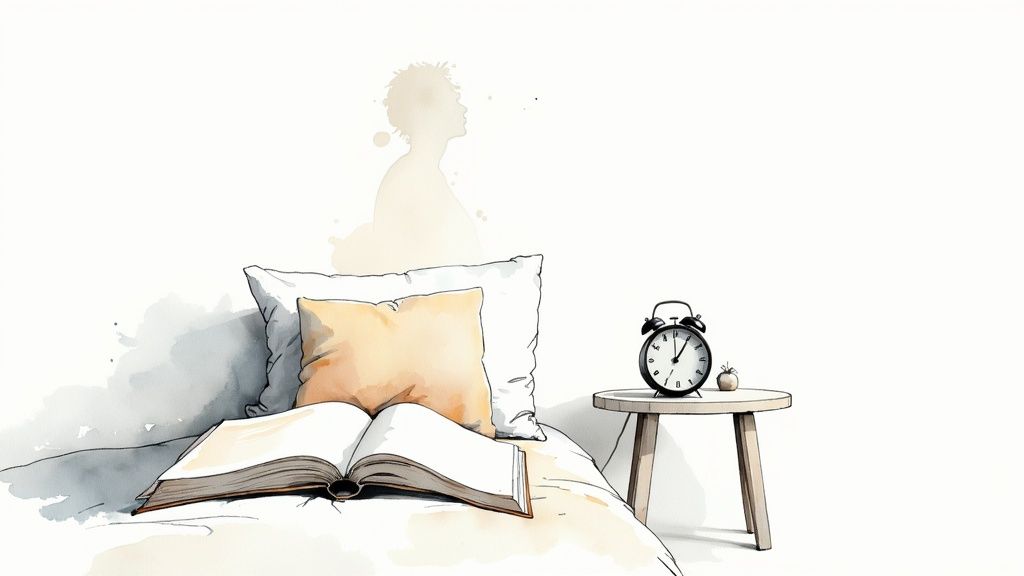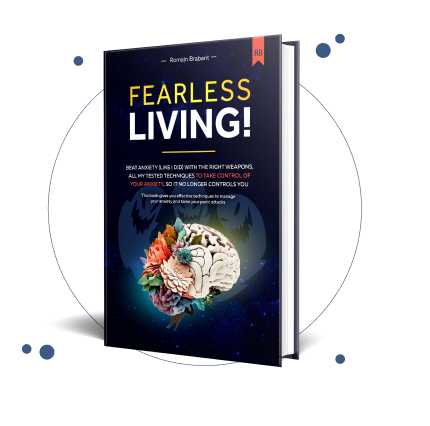
Living with anxiety can often feel like a relentless storm, where the threat of panic is always on the horizon. It's an exhausting, isolating experience that can trap you into believing this is your permanent reality. But what if there was a different path available? A path not defined by constant struggle, but by intentional healing and a rediscovered sense of freedom. This isn't about ignoring the very real challenges of anxiety; it's about providing tangible hope and a structured plan to navigate them successfully. The journey from enduring chronic anxiety to living a panic-free life is absolutely possible, and it begins with understanding where to focus your energy.
This comprehensive mental health checklist is designed to be your personal roadmap to healing. We will move beyond generic advice and delve into eight fundamental pillars of mental wellness, providing actionable steps and fresh perspectives to help you regain control. For those looking to move beyond anxiety and embrace a fearless life, a comprehensive understanding of how to manage anxious feelings is crucial. This praktische gids voor het omgaan met angst offers a great starting point for developing those skills.
Think of this article as your guide to not just managing anxiety, but actively building a life where you are in the driver's seat. Each section is crafted to empower you with practical, effective tools. Together, we will explore daily sleep assessments, mood tracking, social connection, stress management, and more. The goal is to equip you with a system that fosters hope and builds lasting resilience, allowing you to move from merely surviving to truly thriving.
1. Daily Sleep Quality Assessment
A cornerstone of any effective mental health checklist is a systematic review of your sleep. Far from just counting hours, a Daily Sleep Quality Assessment is a deliberate process of evaluating how your rest patterns directly influence your emotional stability and cognitive clarity. This involves tracking not just duration but also the quality of your sleep, including how easily you fall asleep, how often you wake, and how you feel upon waking. This consistent practice helps reveal the powerful link between sleep and your ability to manage anxiety, offering a tangible path toward feeling more in control and less overwhelmed.

Pioneered by experts like Dr. Matthew Walker and advanced by institutions like the Stanford Sleep Medicine Center, this approach treats sleep as a foundational pillar of mental wellness. Research consistently shows that poor sleep exacerbates anxiety and can even trigger panic attacks, while restorative sleep bolsters emotional resilience. For example, Veterans Affairs hospitals integrate sleep tracking into PTSD treatment protocols, recognizing that healing from trauma is profoundly difficult without first addressing sleep disturbances. By systematically improving your sleep, you create the biological conditions necessary for your mind to heal and find calm.
How to Implement Your Sleep Assessment
Getting started is simple and doesn't require expensive gadgets. The goal is to build awareness and identify patterns that you can change.
- Use a 1-10 Rating System: Each morning, rate your sleep quality on a scale of 1 to 10. A "1" might mean a restless night with frequent waking, while a "10" signifies deep, uninterrupted rest. Jot this down in a journal or a note on your phone.
- Track Key Metrics: Alongside your rating, note your bedtime, approximate time you fell asleep, and the number of times you woke up. This data helps connect specific behaviors to outcomes.
- Focus on Consistency: Instead of aiming for a perfect eight hours every night, prioritize a consistent bedtime and wake-up time, even on weekends. This stabilizes your circadian rhythm, which is crucial for regulating mood and energy.
- Create a "Sleep Environment Checklist": Is your room dark, quiet, and cool? Audit your bedroom for disruptors like light from electronics or outside noise and address them one by one.
This proactive approach to sleep is more than just a routine; it's an act of hope. It provides clear, actionable steps you can take every single day to build a foundation for a panic-free life, proving that you have the power to influence your mental state.
2. Mood and Emotion Tracking
A crucial component of any comprehensive mental health checklist is the practice of Mood and Emotion Tracking. This is not about judging your feelings but rather observing them with curiosity and precision. By systematically logging your emotional states, you can begin to identify the specific triggers, patterns, and subtle shifts that influence your mental wellbeing. This structured awareness is empowering; it transforms vague feelings of anxiety into a clear set of data, illuminating the connections between your daily activities and your emotional responses, which is a vital step toward managing panic and reclaiming your inner peace.

This method is central to evidence-based therapies like Cognitive Behavioral Therapy (CBT) and is championed by leading figures such as Dr. Kay Redfield Jamison for its effectiveness in managing complex conditions like bipolar disorder. Major institutions like the Mayo Clinic integrate mood tracking into treatment protocols, while digital mental health platforms like Daylio and Sanvello have made this powerful tool accessible to millions. Research from the University of Pennsylvania consistently demonstrates that regular mood monitoring helps individuals recognize early warning signs of a depressive or anxious episode, allowing for preemptive action. By tracking your emotions, you are not just passively observing; you are actively engaging in a process that builds resilience and proves that a life free from the grip of panic is achievable.
How to Implement Your Mood and Emotion Tracking
Getting started with mood tracking is straightforward and can be adapted to your personal style. The aim is to create a consistent habit that yields actionable insights.
- Use a Simple Rating Scale: To avoid feeling overwhelmed, use a simple 1-5 or 1-10 scale to rate your mood at set times, such as morning, afternoon, and evening. A "1" could represent a very low or anxious mood, while a "10" signifies a positive and calm state.
- Note Context and Triggers: Alongside your rating, briefly note what was happening. Were you at work? Did you just have a coffee? Did you interact with a specific person? This context is key to identifying your unique triggers.
- Track at Consistent Times: Set reminders to log your mood at the same times each day. This consistency helps create a reliable baseline and makes it easier to spot deviations that signal a shift in your mental state.
- Review Weekly, Not Daily: Avoid getting lost in daily fluctuations. Set aside time once a week to review your log for broader patterns. You might notice, for example, that your anxiety consistently spikes on Sunday evenings, giving you a clear target for intervention. For those looking to deepen this practice, journaling can offer even more profound insights. You can learn more about the benefits of journaling for mental health.
This proactive approach demystifies your emotional landscape. It provides tangible evidence that your feelings are manageable and often linked to identifiable causes, offering you a clear roadmap toward healing and lasting calm.
3. Social Connection and Relationship Evaluation
A vital component of any robust mental health checklist is a deliberate evaluation of your social connections and relationships. This isn't just about how many friends you have; it's a conscious assessment of the quality of your interactions and the strength of your support system. Regularly examining who energizes you versus who drains you helps identify patterns of connection or isolation that profoundly impact your emotional well-being. This practice illuminates the direct link between healthy relationships and your capacity to navigate anxiety, offering a clear path toward feeling understood, supported, and less alone on your journey to healing.

The importance of this is championed by figures like Dr. Robert Waldinger of the Harvard Study of Adult Development and Dr. Vivek Murthy, who has highlighted the loneliness epidemic. The Harvard study, spanning over 80 years, conclusively found that strong, high-quality relationships are the single greatest predictor of long-term happiness and health. Similarly, the support structure in programs like Alcoholics Anonymous, where sponsors provide direct guidance, shows how dedicated connections can foster resilience. By intentionally cultivating your social health, you build an external defense system that reinforces your internal ability to find calm and heal from panic.
How to Implement Your Relationship Evaluation
Getting started involves mindful reflection rather than a complex social audit. The goal is to build awareness of how your relationships affect your mental state so you can nurture the ones that help you thrive.
- Conduct a Monthly Relationship Audit: Unlike daily check-ins for sleep or mood, a monthly review is more effective. Ask yourself: "Which interactions left me feeling energized and supported this month?" and "Which ones left me feeling drained or anxious?"
- Identify Your Crisis Support Team: Proactively list 2-3 people you can confidently reach out to during a moment of high anxiety or panic. Having this list ready removes the guesswork when you need support the most.
- Schedule Connection Time: Be intentional about reaching out to your supportive friends or family. A simple text, a quick call, or a scheduled coffee date can reinforce these crucial bonds and combat feelings of isolation.
- Practice Setting Healthy Boundaries: Recognizing and limiting time with people who consistently drain your energy is a critical act of self-preservation. This creates more space for relationships that are reciprocal and uplifting. For a deeper look into how relationships and anxiety interact, you can learn more about managing anxiety within partnerships on anxietychecklist.com.
This focused approach to your social world is an empowering strategy. It confirms that you don't have to face anxiety alone and gives you actionable steps to build a network of support, creating a foundation of connection that is essential for a panic-free life.
4. Stress Level and Coping Mechanism Assessment
A critical component of any functional mental health checklist is the regular assessment of your stress levels and the effectiveness of your coping strategies. This isn't just about acknowledging you feel stressed; it's a structured evaluation of where that stress comes from and whether your responses are helping or harming you. By identifying specific stressors and analyzing how you manage them, you can move from a state of reactive crisis management to proactive emotional regulation, creating a clear pathway toward a calmer, more predictable life.
The concept of actively managing stress was pioneered by researchers like Dr. Hans Selye and modernized by Dr. Jon Kabat-Zinn with mindfulness-based stress reduction. Leading organizations now integrate this approach; Google's employee wellness programs and the U.S. Military's Master Resilience Training both emphasize identifying stressors and building effective coping toolkits. These programs prove that stress is not something you must simply endure. Instead, by systematically assessing and responding to it, you build the resilience needed to prevent stress from escalating into overwhelming anxiety or panic, reinforcing your innate ability to heal.
How to Implement Your Stress and Coping Assessment
This assessment empowers you to understand your triggers and build a personalized response plan. The goal is to gain clarity and control before stress becomes unmanageable.
- Use a 'Stress Thermometer': Twice daily, morning and evening, rate your stress on a scale of 1 to 10. A "1" is complete calm, while a "10" is extreme distress. This simple metric reveals patterns in when and why your stress spikes.
- Categorize Your Stressors: List what's causing your stress and sort each item into two columns: 'Controllable' (e.g., a messy room, an unfinished work task) and 'Uncontrollable' (e.g., traffic, a colleague's mood). This helps you focus your energy where it matters most.
- Build a 'Coping Toolbox': Create a written list of 5 to 10 healthy coping mechanisms you can turn to. Include a mix of strategies, such as a 5-minute walk, a specific breathing exercise, listening to a calming song, or practicing mindfulness. For more guidance, you can explore how meditation can reduce anxiety.
- Practice Proactively: Don't wait until your stress is an 8 or 9 to use your tools. When you notice your 'stress thermometer' rising to a 4 or 5, intentionally deploy a strategy from your toolbox. This builds the habit of managing stress before it takes over.
This structured approach transforms stress from a mysterious, powerful force into a solvable problem. It's a daily declaration of your commitment to your well-being, proving that you have the tools and the power to navigate challenges without succumbing to panic.
5. Physical Health and Mental Health Connection Review
A critical component of a comprehensive mental health checklist is reviewing the deep connection between your physical and mental states. This goes beyond simple diet and exercise; it’s an ongoing evaluation of how physical factors like nutrition, activity levels, medical conditions, and substance use directly influence your mood, energy, and cognitive function. This assessment recognizes the powerful, bidirectional relationship between body and mind, helping you identify and adjust key lifestyle indicators that can either fuel anxiety or foster calm. It offers a tangible way to regain influence over your well-being, providing hope that small, physical changes can lead to profound mental relief.

This integrated approach is championed by pioneers like Dr. John Ratey, author of Spark, who details how exercise physically remodels the brain to combat anxiety and depression. Leading institutions like the Mayo Clinic and Kaiser Permanente now use integrated care models that treat physical and mental health simultaneously, acknowledging that one cannot be healed without addressing the other. For instance, the NHS in the UK often prescribes structured physical activity for mild depression, and UCLA's research programs demonstrate exercise's effectiveness as a therapy for anxiety. This evidence confirms that actively managing your physical health is a direct and powerful strategy for building a panic-free life.
How to Implement Your Physical-Mental Health Review
Integrating this review into your life is about building awareness and making intentional, small-scale adjustments. The goal is to see how your body’s state directly impacts your mind.
- Start with Small Bursts of Movement: You don't need intense workouts. Begin with just 10-15 minutes of daily activity, like a brisk walk. Notice how you feel before and after to build positive reinforcement.
- Conduct an 'Energy Audit': Keep a simple log for a few days. Note which activities, foods, and interactions give you physical energy versus which ones drain you. This helps you make informed choices that support your mental state.
- Track Your Nutrition's Impact: Monitor your energy and mood after meals to identify how certain foods affect you. Consider how caffeine or alcohol influences your anxiety levels and sleep quality, making adjustments as needed. You can learn more about how lifestyle and diet changes can manage anxiety.
- Factor in Your Environment: Your physical surroundings play a role. Additionally, consider the impact of your physical environment on mental health; you can learn more about the positive effects of natural light by exploring resources on the health benefits of installing a skylight.
This method is a declaration of empowerment. It puts you back in the driver's seat by showing you how simple, physical actions can create the biological foundation for mental clarity and emotional resilience, proving that healing is within your reach.
6. Goal Setting and Achievement Progress
A vital component of a comprehensive mental health checklist is the systematic review of your personal goals and your progress toward them. Goal Setting and Achievement Progress is a deliberate practice of defining meaningful objectives and tracking your journey, which restores a sense of control and purpose. This process helps counter the feelings of helplessness that often accompany anxiety, shifting your focus from overwhelming fears to empowering, manageable actions. Consistently engaging with your goals provides tangible evidence of your capability and resilience, directly boosting self-esteem and building momentum toward a more stable, fulfilling life.
This approach is heavily supported by decades of research, notably Dr. Edwin Locke's goal-setting theory and the work of positive psychology pioneers like Dr. Martin Seligman. The principle is that clear, challenging goals create direction and energize behavior. We see this in highly effective systems like the 30/60/90-day milestones in Alcoholics Anonymous, which provide a clear roadmap for recovery, or in Stephen Covey’s “7 Habits of Highly Effective People,” which ties goal achievement to core values. By setting and pursuing goals, you are actively scripting a future where you are not defined by anxiety, but by your aspirations and accomplishments.
How to Implement Goal Setting and Progress Tracking
The key is to create a structure that motivates rather than overwhelms. This method gives you a proactive way to build self-worth and see your own strength.
- Set 2-3 Small, Achievable Goals: Instead of a massive, intimidating objective, start small. For example, aim for a 10-minute walk three times this week, not running a marathon. This builds a foundation of success.
- Focus on Process, Not Just Outcome: Concentrate on goals within your control. Instead of "lose 20 pounds" (an outcome), focus on "prepare healthy lunches four days a week" (a process). This makes success about effort, not just results.
- Link Goals to Your Core Values: Ask yourself why a goal matters. If you value connection, a goal might be to call one friend each week. This intrinsic motivation is a powerful defense against anxiety-driven apathy.
- Review and Adjust Monthly: Life happens. A monthly check-in allows you to adjust your goals based on your current circumstances without feeling like a failure. Flexibility is a sign of strength.
- Celebrate Every Small Win: Acknowledging progress is crucial. Did you complete your 10-minute walk? Take a moment to genuinely praise yourself. This rewires your brain to associate action with positive reinforcement.
This intentional approach to goal setting is a declaration of hope. It demonstrates that you can steer your own life, moving from a state of passive worry to one of active creation, proving every day that a panic-free life is not just possible, but something you are building with your own hands.
7. Professional Support and Treatment Compliance
A crucial element of a proactive mental health checklist involves evaluating your engagement with professional care. Assessing your Professional Support and Treatment Compliance means taking an honest look at how you partner with your healthcare providers. It goes beyond just showing up for appointments; it’s about actively participating in your treatment, adhering to prescribed plans, and regularly determining if your current support system truly meets your evolving needs. This self-audit transforms you from a passive recipient of care into an active collaborator, ensuring your journey toward healing is both effective and aligned with your personal goals.
This collaborative approach is championed by leading organizations like the American Psychological Association and the National Institute of Mental Health, which emphasize evidence-based practice and patient engagement. Models like Kaiser Permanente's integrated mental health care show that when patients work closely with their teams, outcomes improve dramatically. Similarly, the wraparound services at community mental health centers are built on this principle of active compliance and communication. By consistently assessing your treatment, you ensure you are receiving the most effective care possible, providing a structured and hopeful path toward managing your mental health and living a life free from the grip of panic.
How to Implement Your Support Assessment
Engaging with your treatment plan effectively requires regular, honest check-ins with yourself and your providers. The goal is to optimize your path to recovery.
- Schedule a "Provider Fit" Review: Every 3-6 months, ask yourself: Do I feel heard, respected, and understood by my therapist or doctor? Is this professional relationship helping me move forward? It's okay to seek a new provider if the fit isn't right.
- Prepare for Appointments: Before each session, jot down 2-3 key topics, concerns, or recent challenges you want to discuss. This ensures your time is focused and productive.
- Practice Radical Honesty: Be open about your progress, setbacks, and any medication side effects. Your providers can only help you effectively if they have accurate information.
- Activate Therapy Between Sessions: True progress often happens when you apply what you learn. Actively use therapy homework, practice coping strategies, and implement the recommendations discussed during your appointments.
- Create a Professional Crisis Plan: Know exactly who to call when you feel overwhelmed. Keep the contact information for your therapist, psychiatrist, and local crisis line easily accessible. Learn more about how to find the right psychotherapy for anxiety to build this support system.
This structured approach to your professional care is an empowering act of self-advocacy. It reinforces the belief that recovery is not only possible but is a process you can actively guide, giving you tangible control and a clear road map to a calmer, more stable future.
8. Daily Routine and Structure Evaluation
A fundamental item on any serious mental health checklist is the evaluation of your daily routine and structure. This goes beyond simple time management; it’s about intentionally designing a predictable framework for your day that reduces mental load and fosters a sense of security. By establishing consistent patterns for waking, working, eating, and resting, you create an environment of stability where your mind doesn't have to constantly adapt to chaos. This structured approach is a powerful tool for grounding yourself, minimizing decision fatigue, and reclaiming control when anxiety feels overwhelming.
The power of routine is championed by figures like Hal Elrod in "The Miracle Morning" and has been a cornerstone of well-being practices for centuries, from monastic daily schedules to military protocols for veteran mental health. Research and clinical practice show that a lack of structure can amplify feelings of anxiety and depression, while a reliable routine provides an anchor. For instance, many autism support programs use highly structured daily schedules to reduce distress and improve functioning, demonstrating how predictability calms the nervous system. Implementing a routine is a proactive declaration that you can build a stable foundation, even when your internal world feels turbulent.
How to Implement Your Routine Evaluation
Creating a supportive structure doesn't mean your life has to become rigid or boring. The goal is to build a reliable yet flexible framework that serves your mental health needs.
- Start with 'Routine Anchors': Instead of overhauling your entire day, begin by setting one or two key activities at the same time daily. This could be a consistent wake-up time, a 15-minute morning walk, or a specific time you shut down your work computer.
- Build in Flexibility: A healthy routine has room for life to happen. Plan your core activities but leave unscheduled blocks of time. This prevents the structure from becoming another source of stress if you deviate from it.
- Balance Productivity and Restoration: Your daily schedule must include both tasks that give you a sense of accomplishment and activities that are purely for rest and enjoyment. Neglecting restoration leads to burnout, which fuels anxiety.
- Regularly Review and Adjust: Your needs will change. At the end of each week, ask yourself: "Did my routine support me, or did it feel like a burden?" Adjust it to better serve your current energy levels and priorities.
This methodical approach to your day is a profound act of self-care. It provides the predictability your mind craves to feel safe, offering tangible proof that you can architect a life that supports calm and makes a panic-free existence achievable.
Mental Health Checklist: 8-Point Comparison
| Item | Implementation Complexity 🔄 | Resource Requirements ⚡ | Expected Outcomes 📊 | Ideal Use Cases 💡 | Key Advantages ⭐ |
|---|---|---|---|---|---|
| Daily Sleep Quality Assessment | Low – simple tracking and ratings | Minimal tools (sleep tracker or journal) | Improved mood regulation, better cognitive function | Monitoring sleep hygiene to support mental health | Direct impact on mood, easy to track |
| Mood and Emotion Tracking | Moderate – regular logging needed | Apps or journals for frequent entries | Increased self-awareness, early episode detection | Identifying emotional patterns and triggers | Helps early intervention, enhances insight |
| Social Connection and Relationship Evaluation | Moderate – requires reflection and communication | Time for social interaction and assessment | Reduced depression/anxiety risk, stronger support systems | Evaluating social support and isolation | Builds accountability, increases belonging |
| Stress Level and Coping Mechanism Assessment | Moderate – requires monitoring and evaluation | Stress rating tools, coping strategy development | Proactive stress management, reduced health risks | Identifying stressors and improving coping | Prevents overwhelm, personalizes coping |
| Physical Health and Mental Health Connection Review | Moderate to High – lifestyle monitoring and changes | Exercise, nutrition tracking, medical coordination | Improved mental well-being, energy, mood stabilization | Integrating physical health factors into mental health plans | Addresses root causes, actionable improvements |
| Goal Setting and Achievement Progress | Moderate – systematic goal planning and reviews | Goal tracking tools or journals | Enhanced motivation, self-efficacy, structured positive change | Supporting progress and purpose in mental health recovery | Builds confidence, maintains motivation |
| Professional Support and Treatment Compliance | High – requires engagement with healthcare providers | Access to professionals, therapy, medication | Better treatment outcomes, expert guidance | Monitoring therapy adherence and treatment effectiveness | Evidence-based support, expert intervention |
| Daily Routine and Structure Evaluation | Moderate – routine creation and tracking | Time management tools or checklists | Greater stability, reduced stress, improved productivity | Establishing stable daily habits to enhance mental health | Reduces decision fatigue, supports healthy habits |
Your Personalized Toolkit for a Fearless Life
Navigating the landscape of your mental health can often feel like trying to find your way through a dense, unfamiliar forest without a map. The mental health checklist items we've explored are not just random points of interest; they are your compass, your map, and your survival gear. They are the tangible tools that empower you to not only navigate but to thrive, transforming the frightening wilderness of anxiety into a manageable and, eventually, peaceful terrain.
This journey is about moving beyond mere survival. It’s about crafting a life defined by courage, connection, and calm. Each element of the checklist, from meticulously tracking your sleep to intentionally evaluating your social connections, serves as a critical building block. These are not passive observations. They are active, powerful interventions that, when practiced consistently, dismantle the very foundation upon which anxiety and panic attacks build their power.
From Checklist to Lived Experience
The true power of a mental health checklist isn't in the abstract concepts but in its daily application. Think of it as building a muscle. You wouldn't expect to lift a heavy weight after one trip to the gym. Similarly, building resilience against anxiety is a process of consistent, intentional effort.
- Sleep Quality Assessment becomes your nightly reset, ensuring your mind has the foundational rest it needs to process emotions and manage stress effectively.
- Mood and Emotion Tracking acts as your personal emotional dialect, helping you understand your internal world with clarity instead of being overwhelmed by it.
- Social Connection Evaluation is your lifeline, reminding you that you are not isolated and that meaningful relationships are a powerful antidote to fear.
- Daily Routine and Structure provide the scaffolding for your day, creating predictability and safety that starves anxiety of the chaos it craves.
By engaging with these practices, you are sending a profound message to your nervous system: "I am in control. I am safe. I have the tools to handle this." This is the cornerstone of healing from chronic anxiety and living a life free from the dread of panic.
The Path to a Panic-Free Future
Remember, the goal is not to eliminate all feelings of anxiety forever. That's an unrealistic and unhelpful standard. Anxiety is a normal human emotion. The true victory is in changing your relationship with it. It’s about transforming it from a terrifying, monstrous force that dictates your every move into a manageable signal that you can acknowledge, understand, and respond to with confidence.
You have now seen the blueprint. You understand that your physical health, your daily habits, your social world, and your internal emotional state are all interconnected. The path forward is about integrating these insights into a cohesive, personalized system. It is about taking these individual checklist items and weaving them into the fabric of your life until they become second nature.
This process is a profound act of self-compassion and empowerment. Every time you consciously check in with your sleep, your mood, or your stress levels, you are taking a small but significant step away from fear and toward freedom. Healing is not a linear race to a finish line; it is a journey of accumulating these small, consistent victories. You have the inherent capacity to create lasting, positive change. With the right strategies and a commitment to your well-being, a life defined by purpose and joy, not by panic, is not just a hopeful dream, it is an achievable reality.
Ready to transform these principles into a powerful daily practice? The Anxiety Checklist provides a comprehensive 93-point interactive system and the 'Fearless Living' eBook, developed by a 15-year anxiety survivor, to help you build your own actionable mental health checklist. Start your journey to a calmer, more confident life today by visiting The Anxiety Checklist.

